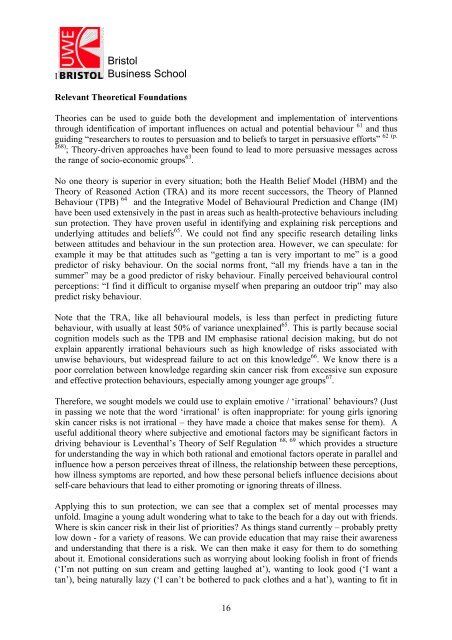PDF (Sun Protection / Skin Cancer Detection Report for the South ...
PDF (Sun Protection / Skin Cancer Detection Report for the South ...
PDF (Sun Protection / Skin Cancer Detection Report for the South ...
Create successful ePaper yourself
Turn your PDF publications into a flip-book with our unique Google optimized e-Paper software.
I<br />
Bristol<br />
Business School<br />
Relevant Theoretical Foundations<br />
Theories can be used to guide both <strong>the</strong> development and implementation of interventions<br />
through identification of important influences on actual and potential behaviour 61 and thus<br />
62 (p.<br />
guiding “researchers to routes to persuasion and to beliefs to target in persuasive ef<strong>for</strong>ts”<br />
268)<br />
; Theory-driven approaches have been found to lead to more persuasive messages across<br />
<strong>the</strong> range of socio-economic groups 63 .<br />
No one <strong>the</strong>ory is superior in every situation; both <strong>the</strong> Health Belief Model (HBM) and <strong>the</strong><br />
Theory of Reasoned Action (TRA) and its more recent successors, <strong>the</strong> Theory of Planned<br />
Behaviour (TPB) 64 and <strong>the</strong> Integrative Model of Behavioural Prediction and Change (IM)<br />
have been used extensively in <strong>the</strong> past in areas such as health-protective behaviours including<br />
sun protection. They have proven useful in identifying and explaining risk perceptions and<br />
underlying attitudes and beliefs 65 . We could not find any specific research detailing links<br />
between attitudes and behaviour in <strong>the</strong> sun protection area. However, we can speculate: <strong>for</strong><br />
example it may be that attitudes such as “getting a tan is very important to me” is a good<br />
predictor of risky behaviour. On <strong>the</strong> social norms front, “all my friends have a tan in <strong>the</strong><br />
summer” may be a good predictor of risky behaviour. Finally perceived behavioural control<br />
perceptions: “I find it difficult to organise myself when preparing an outdoor trip” may also<br />
predict risky behaviour.<br />
Note that <strong>the</strong> TRA, like all behavioural models, is less than perfect in predicting future<br />
behaviour, with usually at least 50% of variance unexplained 65 . This is partly because social<br />
cognition models such as <strong>the</strong> TPB and IM emphasise rational decision making, but do not<br />
explain apparently irrational behaviours such as high knowledge of risks associated with<br />
unwise behaviours, but widespread failure to act on this knowledge 66 . We know <strong>the</strong>re is a<br />
poor correlation between knowledge regarding skin cancer risk from excessive sun exposure<br />
and effective protection behaviours, especially among younger age groups 67 .<br />
There<strong>for</strong>e, we sought models we could use to explain emotive / ‘irrational’ behaviours? (Just<br />
in passing we note that <strong>the</strong> word ‘irrational’ is often inappropriate: <strong>for</strong> young girls ignoring<br />
skin cancer risks is not irrational – <strong>the</strong>y have made a choice that makes sense <strong>for</strong> <strong>the</strong>m). A<br />
useful additional <strong>the</strong>ory where subjective and emotional factors may be significant factors in<br />
driving behaviour is Leventhal’s Theory of Self Regulation 68, 69 which provides a structure<br />
<strong>for</strong> understanding <strong>the</strong> way in which both rational and emotional factors operate in parallel and<br />
influence how a person perceives threat of illness, <strong>the</strong> relationship between <strong>the</strong>se perceptions,<br />
how illness symptoms are reported, and how <strong>the</strong>se personal beliefs influence decisions about<br />
self-care behaviours that lead to ei<strong>the</strong>r promoting or ignoring threats of illness.<br />
Applying this to sun protection, we can see that a complex set of mental processes may<br />
unfold. Imagine a young adult wondering what to take to <strong>the</strong> beach <strong>for</strong> a day out with friends.<br />
Where is skin cancer risk in <strong>the</strong>ir list of priorities? As things stand currently – probably pretty<br />
low down - <strong>for</strong> a variety of reasons. We can provide education that may raise <strong>the</strong>ir awareness<br />
and understanding that <strong>the</strong>re is a risk. We can <strong>the</strong>n make it easy <strong>for</strong> <strong>the</strong>m to do something<br />
about it. Emotional considerations such as worrying about looking foolish in front of friends<br />
(‘I’m not putting on sun cream and getting laughed at’), wanting to look good (‘I want a<br />
tan’), being naturally lazy (‘I can’t be bo<strong>the</strong>red to pack clo<strong>the</strong>s and a hat’), wanting to fit in<br />
16

















